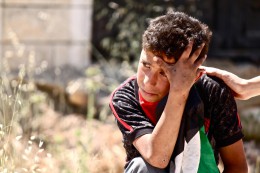Aida camp was established in 1950 between the towns of Bethlehem and Beit Jala. Like other West Bank camps, it was established on land UNRWA leased from the government of Jordan. Aida covers a small area of 0.71 square kilometres that has not grown significantly with the refugee population. As such, it faces severe overcrowding problems. In many cases, the UNRWA installations in Aida camp also provide services for the refugees in the nearby Beit Jibrin camp. The camp is fully linked to municipal electricity and water grids, but the sewage and water networks are poor.
The original refugees in Aida camp generally hailed from 27 villages in the western Jerusalem and western Hebron areas, including Walaja, Khirbet El Umur, Qabu, Ajjur, Allar, Deir Aban, Maliha, Ras Abu Ammar and Beit Nattif. Initially, the camp started as a safe zone with the promise that the refugees could return to their villages after the conflict was over. At this time, the camp hosted 1125 refugees living in 94 tents.
The lives of those living on the camp has been troubled, not only because of their status as refugees, and the hardships this entails, but also by the traumatizing and devastating experiences of the first and second intifadas.
During the first Intifada, from 1987-1993, curfews and gunfire were frequent occurrences on the camp. Only seven years after the end of the first Intifada, increasing Palestinian dissatisfaction with peace negotiations and other events saw the rise of the second Intifada in 2000. During this time the residents of Aida camp experienced severe hardship, with every aspect of their daily lives completely hampered by the reality of military attacks. The camp was subject to frequent strikes and invasions from both land and air, in addition to severe curfew measures imposed on the camp and surrounding areas. Even when not under curfew, residents could not travel anywhere within the camp where their movement could be seen from military bases, as they would risk coming under fire.
Even within their homes, residents were not safe. As many houses were made from cinder block and inexpensive building materials, they could not sustain gunfire, in contrast to the fortified military camps and lookout posts from which the Israeli forces attacked the camp. When invading the camp, Israeli forces occupied homes, made arbitrary arrests and even bombed the walls to neighboring homes in order to travel through the camp internally, showing a disregard for injuries that could occur.
Needless to say, the impact of such events on the camp was devastating. The attacks killed, injured and traumatized many. The whole infrastructure of the camp was severely damaged, including the UNRWA schools on the camp and many of the roads, where tanks had damaged the ground and surrounding property in the camp’s narrow streets. Reconstruction was a slow process, and it was not until preparations for Pope Benedict XVI’s visit to the camp in 2009 that the main road, still showing signs of damage from Israeli tanks, was repaired.
The recent history of the camp is plagued by, in 2003, the construction of the Israeli separation wall, which borders the camp on two sides. Many of the working men in the camp are skilled construction workers, reliant on the Israeli job market. As the restrictions on work permits for Israel were tightened after the beginning of the Second Intifada in 2000, these men found it increasingly difficult to gain work. With the construction of the separation wall, they were no longer able to access the Israeli job market, and could not be absorbed into the weak Palestinian economy after losing their jobs in Israel.
As a result the unemployment levels in the camp have now increased to 43%. Currently 39% of the residents in Aida camp are living in poverty, on less than $2 a day. The wall has also cut off the camp from farmland and recreational areas for its youth. Throughout its course along the West Bank, the wall significantly deviates from the Green Line, and annexes 8.5% of the West Bank to Israeli territory. Likewise, the wall surrounding Aida camp is significantly further south than the actual Green line, and annexes the Jewish settlements of Gilo and Har Homa to Israeli territory. The residents of Aida camp are also sealed off from nearby East Jerusalem just kilometers away, an area of religious importance and regarded under international law as Palestinian territory. The people of Aida now live in the shadow of the 8m high concrete barrier surrounding their camp.
Aida Youth Center, as the rest of the camp, has faced many obstacles and difficulties throughout its history. It was founded to enhance the lives of the youth of the Camp, but was closed by the Israeli authorities in the late 1970s, only to reopen again and continue its work. Then, in 1998, the centre was closed for five years because Israeli tanks demolished the property, and it was completely destroyed. However, despite these problems, Aida Youth Center has continued to flourish. We reopened in 2004, after the Catholic Relief Services financed the rebuilding of the ground floor of the centre, and the refugees participated voluntarily in the construction. We are also grateful to the Arab Fund for Development who funded the construction of the first and second floors. Since reopening, the center has extended its program of activities to include culture and health activities. Our most recent achievements include creating the ‘largest key in the world’ and ‘the Gate of Return’, a 12m high structure at the entrance to the camp.
